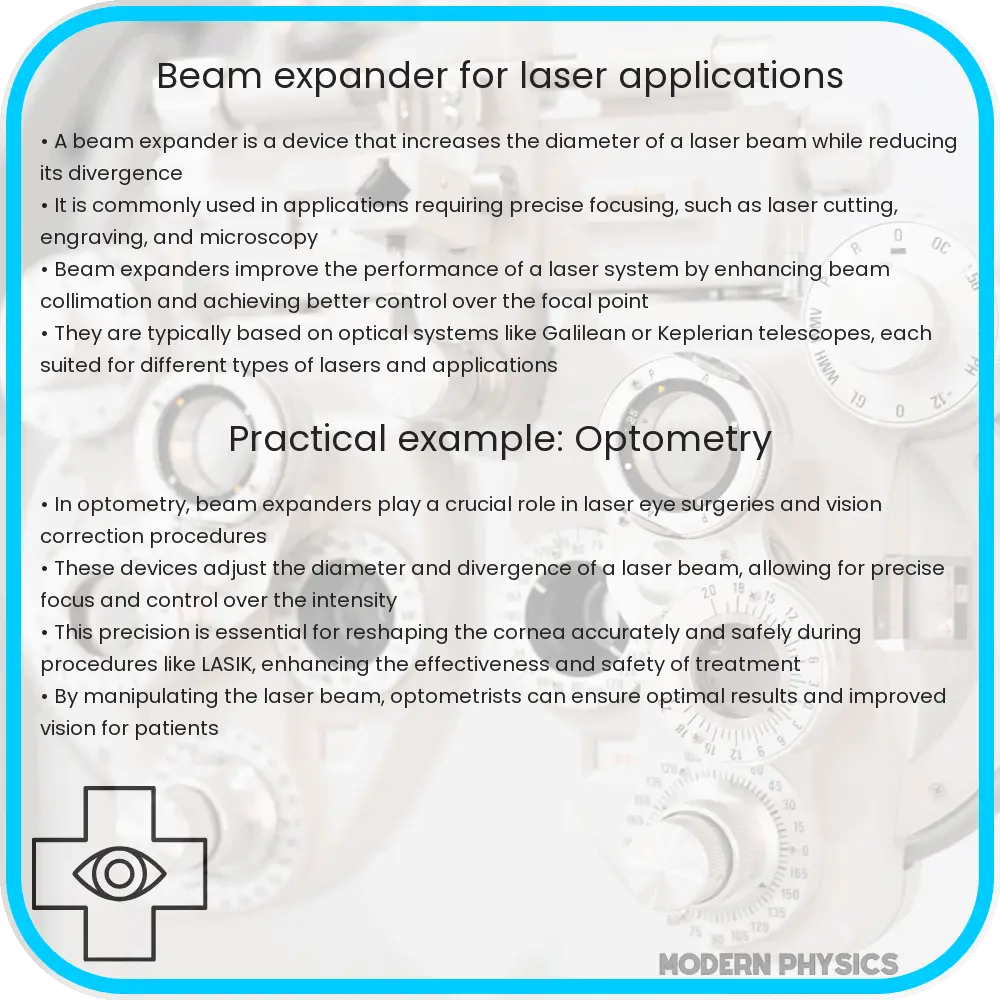Learn about beam expanders, optical devices that adjust light beam diameter and divergence for enhanced precision in lasers and imaging systems.

Beam Expander 101: Precision, Scaling & Optics
Beam expanders are crucial optical devices used extensively in physics and engineering, particularly in applications involving lasers and imaging systems. These devices adjust the diameter of a light beam and its divergence properties, playing a pivotal role in the precision and effectiveness of optical systems. In this introductory exploration, we discuss what beam expanders are, how they operate, and why they are vital in both laboratory and industrial applications.
Understanding Beam Expanders
At its core, a beam expander is designed to increase the width of a laser beam or other light source. This expansion of the beam is critical for applications that require a large, uniform illumination area or precise focusing over long distances. The principle of operation for a beam expander is based on optical magnification, employing lenses or mirrors to achieve the desired beam diameter.
Types of Beam Expanders
There are primarily two types of beam expanders: Keplerian and Galilean. Each type uses a different arrangement of optical elements to achieve beam expansion:
- Keplerian Beam Expander: This type comprises two converging lenses spaced apart at a distance equal to the sum of their focal lengths. The intervening space often contains an aperture to control the beam. The Keplerian expander produces an inverted output beam and is advantageous for its simplicity and adaptability in different optical setups.
- Galilean Beam Expander: Unlike the Keplerian, the Galilean beam expander makes use of a converging lens and a diverging lens. The key advantage of this setup is the non-inverted output beam and a simpler, more compact design. Galilean expanders are preferred in setups where space is limited and beam inversion is undesirable.
Working Principle
The operation of a beam expander can be understood through basic ray optics. Light entering the beam expander is first collimated by the initial lens, aligning the light rays into parallel paths. This process is crucial for maintaining the uniformity of the beam’s phase and intensity profile over distance. The second lens then captures these parallel rays and adjusts their divergence to expand or contract the beam as required.
The magnification factor of a beam expander, describing how much the beam diameter will be increased, is theoretically given by the ratio of the focal lengths of the two lenses (for Keplerian) or the negative ratio of the focal lengths (for Galilean):
Magnification (M) = F2 / F1 (Keplerian)
Magnification (M) = -F2 / F1 (Galilean)
Here, F1 is the focal length of the first lens (positive for converging and negative for diverging), and F2 is the focal length of the second lens.
Applications of Beam Expanders
Beam expanders have a wide range of applications. In laser machining, the expanded beam covers larger areas more uniformly, which enhances the processing speed and quality of the cut or engraved material. In optical communication, beam expanders are employed to reduce the beam divergence, which helps in maintaining the intensity of the signal over longer distances. In scientific research, expanders play a vital role in experimental setups such as atomic and molecular spectroscopy, where precise beam manipulation is required.
Choosing the Right Beam Expander
When selecting a beam expander, it’s crucial to consider several factors to ensure optimal performance in specific applications. These factors include the desired magnification, material compatibility, wavelength of operation, and physical size constraints. For instance, in high-power laser applications, the expanders must be made from materials that can withstand intense light without degrading.
Additionally, the alignment and adjustment capabilities of the beam expander are important for precision applications. Some beam expanders offer fine-tuning of magnification and focus, which can be critical for achieving the highest level of detail and accuracy in processes like microfabrication.
Maintenance and Calibration
Regular maintenance and calibration are essential for sustaining the performance of beam expanders. Over time, optical elements may shift slightly or become contaminated with dust or other particles, which can affect the beam’s quality. Periodic cleaning and realignment of the lenses, as well as checks on the aperture and other mechanical parts, will ensure that the beam expander continues to function effectively.
Calibration involves checking the magnification and divergence of the beam against known standards to ensure that the expander is still performing as expected. This is particularly important in scientific research and precision engineering contexts, where even minor deviations can lead to significant errors.
Conclusion
Beam expanders are sophisticated optical tools that offer extensive utility in a variety of fields ranging from industrial manufacturing to scientific research. Understanding the differences between Keplerian and Galilean types, as well as the principles of operation and factors affecting their performance, helps users choose and maintain the right beam expander for their needs. With proper selection, maintenance, and calibration, beam expanders can greatly enhance the capabilities of many light-based systems, contributing to advancements in technology and science.
